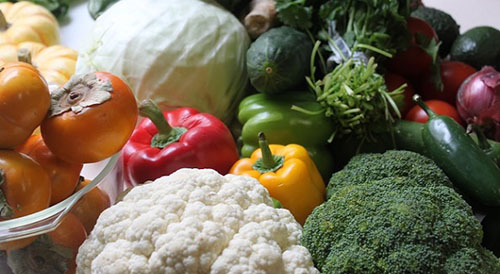You cannot imagine how comforting it is to have fresh produce in hard times. But sometimes your garden just isn’t ready when you need it, or your availability to fresh produce isn’t ideal.

The thing is this though: fresh produce isn’t meant to stay fresh for very long. You’re usually left holding the bag if you want some good produce during a food shortage, societal breakdown or a major event. It’s not that difficult though, to get a good mix of veggies in your diet.
You can even have fresh fruit and vegetables without a huge, well-developed garden or aquaponics setup.
Now, this article is all about veggies and how to make them long term storage type foods but that’s not the only thing these articles are good for. There’s still got a ton of great information you’re going to want.
Don’t forget to stay tuned for the other articles in this series. The work has already been done to uncover the best items for your long-term comfort and survival. When stressful times exist, everyone is going to want to eat great food. Here’s how:
How to store veggies and fruit for the long-term
OK, here’s the deal: fresh produce doesn’t last long. There are more than a few secrets to help you extend the lifespan of fresh cut vegetables for your storage. It’s just that you’ll need to make an accommodation to allow that to happen.
A root cellar is the answer. A root cellar is a cool, humidity controlled room which allows your veggies to last for a very long time. How about lettuce that lasts for two months, garlic that will last two years, squash that will last three years or other root veggies which will last at least two years. THAT’S longevity.
This particular article is meant to whet your appetite and isn’t a big enough forum to cover the actual design and building of a root cellar (there will definitely be a few articles on that topic going forward). Let’s not get into details but simply basic concepts, for now. We WILL however talk more extensively about root cellars in the near future so we won’t be skirting that issue.
But let’s get you salivating for some fresh produce that doesn’t require a fully developed garden or hydro/aqua setup.
Which Fruits and Vegetables Will Work?
Ginger, Onions, Beets, Potatoes, Squash and Hearty leafy greens as well as cabbage are all perfect candidates for root cellaring. The usual suspects can be included of course as well, including apples, carrots, turnips, pumpkin and celery.
Each type of fruit or vegetable will require a different treatment to ensure longevity without refrigeration. But it’s important to note that many items have substantially similar treatments, humidity levels and timelines. For instance, cabbage and celery, leafy greens like kale and chard all store incredibly well in sand with a controlled humidity at the same level. The result is about 3-5 months peak longevity with very little waste involved.
Additionally, squash of all types, potatoes, yams, onions and turnips can all be stored in similar conditions. The key is that they are all “cured” properly in their own unique ways. So, after you prepare the items, you can store them in a very similar environment.
Root cellars are used all around the globe for storing produce.
The best part of the root cellaring ideology is that you don’t have to actually have a cellar, or even a lot of space. In third world countries, “root cellars” are often built out of terracotta pots, sand and water. An unused trashcan can be buried, incorporated with hay and newspaper and covered properly to provide a very cheap and easy to maintain root cellar.
The key to root cellaring is the controlling of humidity (some items need more, some need less). That’s the main reason why different storage vessels make some sense.
What Else Can Be Stored Long Term?
Let’s talk more about the types of food you can store though, because that’s what this is all about. Having fresh produce on hand even when you cannot guarantee access from your garden or the grocer is important.
Ginger root is an excellent vegetable for root cellaring. The rind that forms on the ginger allows the moisture to stay intact until it’s broken, and the relatively firm flesh keeps bruising to a minimum. It is bruising which causes vegetables and fruits to speed up degradation. You know that old saying: “One bad apple ruins the whole bushel”? It’s true. You need ripe, unblemished, uncut and non-bruised produce for root cellaring.
Garlic can be made to last for significant periods of time if properly stored in a root cellar. Having fresh, spicy, sharp garlic on hand can aid in a bunch of different preparations, including for medical reasons. Garlic can last 6 months on your counter, but 18 months or more in a proper root cellar situation. That’s longevity.
Beets and other similar items (like turnips and potatoes) are easy targets for root cellar advocates. These can last over a year, without any significant degradation to taste or texture. The biggest argument for a cellar is that the produce tastes infinitely better than waterlogged canned versions you buy in the store.
Get Started Now!
Now a few words to the wise: veterans of root cellaring will say without question that home grown produce lasts MUCH longer than store bought produce. If you cannot get your garden producing in time, but want to get your root cellar started there is a strategy.
Visit a local produce farm and pick high quality specimens then utilize proper “curing” techniques. Get informed on the proper storage conditions for each variety, then combine the techniques.
P.S. Don’t worry, you won’t be left hanging on a root cellar setup, but this article was just an introduction. There is a ton of great content on food storage coming down the pipeline, because you are probably hungry for great food in your storage.
This article has been written by Ben Worthen for Survivopedia.
Want to be as self-sufficient as possible? Want to learn how to build a root cellar just like the Native Americans did? Then you really need this amazing step-by-step guide. It is called The Lost Ways and it contains all the knowledge of our forefathers.
Here’s just a glimpse of what you’ll find in The Lost Ways:
From Ruff Simons, an old west history expert and former deputy, you’ll learn the techniques and methods used by the wise sheriffs from the frontiers to defend an entire village despite being outnumbered and outgunned by gangs of robbers and bandits, and how you can use their wisdom to defend your home against looters when you’ll be surrounded.
Native American ERIK BAINBRIDGE – who took part in the reconstruction of the native village of Kule Loklo in California, will show you how Native Americans build the subterranean roundhouse, an underground house that today will serve you as a storm shelter, a perfectly camouflaged hideout, or a bunker. It can easily shelter three to four families, so how will you feel if, when all hell breaks loose, you’ll be able to call all your loved ones and offer them guidance and shelter? Besides that, the subterranean roundhouse makes an awesome root cellar where you can keep all your food and water reserves year-round.
From Shannon Azares you’ll learn how sailors from the XVII century preserved water in their ships for months on end, even years and how you can use this method to preserve clean water for your family cost-free.
Mike Searson – who is a Firearm and Old West history expert – will show you what to do when there is no more ammo to be had, how people who wandered the West managed to hunt eight deer with six bullets, and why their supply of ammo never ran out. Remember the panic buying in the first half of 2013? That was nothing compared to what’s going to precede the collapse.
From Susan Morrow, an ex-science teacher and chemist, you’ll master “The Art of Poultice.” She says, “If you really explore the ingredients from which our forefathers made poultices, you’ll be totally surprised by the similarities with modern medicines.” Well…how would you feel in a crisis to be the only one from the group knowledgeable about this lost skill? When there are no more antibiotics, people will turn to you to save their ill children’s lives.
And believe it or not, this is not all…
Table Of Contents:
Making Your Own Beverages: Beer to Stronger Stuff
Ginger Beer: Making Soda the Old Fashioned Way
How North American Indians and Early Pioneers Made Pemmican
Spycraft: Military Correspondence During The 1700’s to 1900’s
Wild West Guns for SHTF and a Guide to Rolling Your Own Ammo
How Our Forefathers Built Their Sawmills, Grain Mills,and Stamping Mills
How Our Ancestors Made Herbal Poultice to Heal Their Wounds
What Our Ancestors Were Foraging For? or How to Wildcraft Your Table
How Our Ancestors Navigated Without Using a GPS System
How Our Forefathers Made Knives
How Our Forefathers Made Snow shoes for Survival
How North California Native Americans Built Their Semi-subterranean Roundhouses
Our Ancestors’Guide to Root Cellars
Good Old Fashioned Cooking on an Open Flame
Learning from Our Ancestors How to Preserve Water
Learning from Our Ancestors How to Take Care of Our Hygiene When There Isn’t Anything to Buy
How and Why I Prefer to Make Soap with Modern Ingredients
Temporarily Installing a Wood-Burning Stove during Emergencies
Making Traditional and Survival Bark Bread…….
Trapping in Winter for Beaver and Muskrat Just like Our Forefathers Did
How to Make a Smokehouse and Smoke Fish
Survival Lessons From The Donner Party
Get your paperback copy HERE
CHECK OUR survival and prepping solutions
If you found this article useful, please like our Facebook page and stay up to date with the latest articles.
WHAT TO READ NEXT:
HOW TO MAKE YOUR OWN BACON (STEP BY STEP GUIDE)
A RETURN TO THE OLD PATHS: HOW TO MAKE PEMMICAN LIKE THE NATIVE AMERICANS
20 LOST RECIPES FROM THE PIONEERS: WHAT THEY COOKED ON THEIR JOURNEY WESTWARD
SEVEN CLASSIC GREAT DEPRESSION ERA RECIPES GRANDMA USED TO MAKE
POTTED MEAT: A LOST SKILL OF LONG TERM MEAT STORAGE
BACK TO BASICS: HOW TO MAKE AND PRESERVE LARD
THE BEST WAY TO STOCKPILE VEGETABLES OFF-GRID
OLD FASHIONED PRESERVING-GRANDPA’S RECIPE FOR CURED SMOKED HAM
HOW TO MAKE GUNPOWDER THE OLD FASHIONED WAY
SURVIVAL HERBAL RECIPES FROM OUR ANCESTORS
HOW TO PRESERVE MEAT FOR SURVIVAL LIKE OUR GRANDFATHERS
OTHER USEFUL RESOURCES:
The 3 Pioneer Survival Lessons We Should Learn
The Most Effective Home Defense Strategies
Old School Hacks for Off-Grid Living
The Medical Emergency Crash Course

One Reply to “Store Veggies For Long Term Step-By-Step”